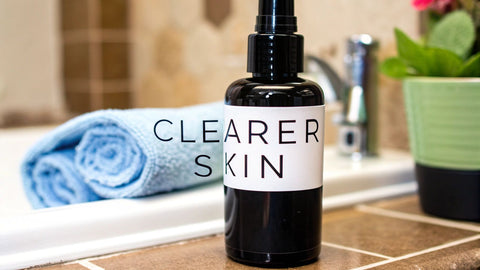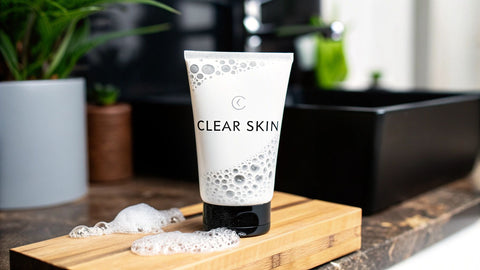How Often Should I Use Salicylic Acid? A Guide to Clear Skin

So, you're ready to add salicylic acid to your routine? Excellent choice. As experts in acne-fighting ingredients at Neutralyze, the number one question we get is, "How often should I actually use it?" It's a critical question because when it comes to powerful actives, more isn't always better.
For almost everyone just starting out, the sweet spot is 2-3 times per week. Think of it as easing your skin into a new workout. You want to build up strength without causing injury. This frequency gives you all the pore-clearing, breakout-fighting benefits of salicylic acid without overwhelming your delicate skin barrier.
Finding Your Salicylic Acid Starting Frequency
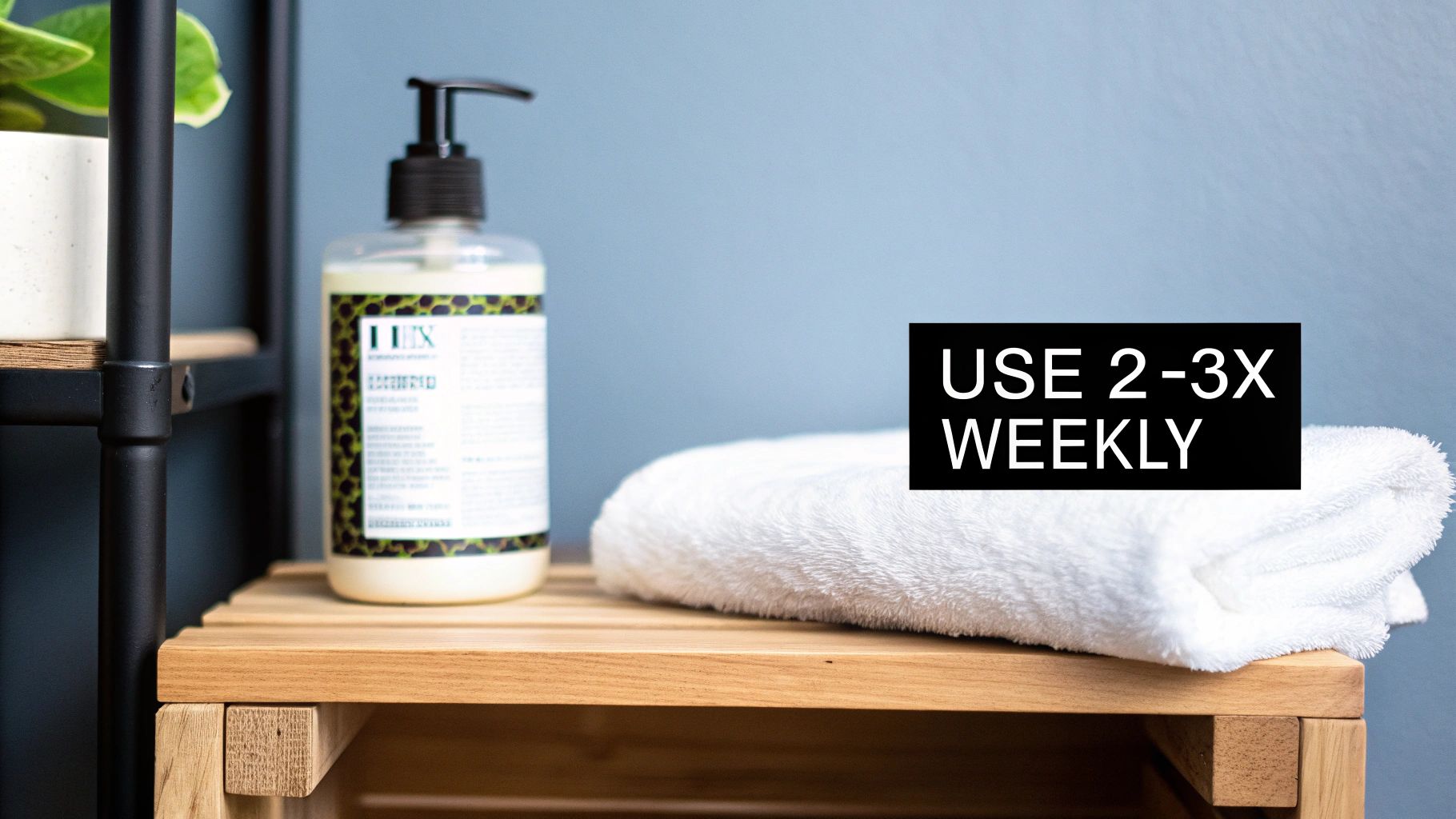
Starting a new active ingredient doesn't have to feel like a chemistry experiment. The goal is to gently introduce a solution that works with your skin, not against it. By beginning with a less-is-more schedule, you're giving your skin time to get acquainted with the ingredient and build tolerance.
This "start low and go slow" method is what most skin experts stand by. It allows your skin to gradually adjust to the exfoliation without triggering irritation. You can see this advice echoed across beauty platforms, like in the guides from The Pink Foundry, because it simply works.
Why Slower Is Better
Trust us, we've seen what happens when people get excited and jump into daily use. It usually leads to a compromised skin barrier—the exact opposite of what you want. We're talking redness, flaking, and even more breakouts.
Instead, a measured approach helps you build up tolerance over time. At Neutralyze, we understand this balance intimately. Our products are expertly formulated to be potent enough to clear acne but are designed for a controlled, gentle start, ensuring your skin remains healthy.
Here’s why taking it slow is non-negotiable:
- Minimize Irritation: This helps you sidestep the classic signs of overuse, like excessive dryness and peeling.
- Build Tolerance: Your skin gets a chance to tell you what it can handle, letting you find your unique sweet spot.
- Ensure Consistency: Let's be real—if a product makes your face red and angry, you're not going to use it. A comfortable routine is a sustainable one, and consistency is the key to clear skin.
The product you choose also plays a big role in your starting frequency. A rinse-off cleanser is a world away from a leave-on serum. Here’s a simple cheat sheet to get you started.
Your Salicylic Acid Starting Point
This table is a simple guide to help you choose your initial usage frequency based on common product types.
| Product Type | Recommended Starting Frequency | Best For |
|---|---|---|
| Cleanser (1-2%) | 3-4 times per week | Oily, resilient skin or those looking for a daily-use option once tolerated. |
| Toner/Serum (2%) | 2-3 times per week (PM only) | Targeted treatment for acne, blackheads, and uneven texture. |
| Spot Treatment (2%+) | As needed on active breakouts | Zapping individual pimples without treating the entire face. |
| Moisturizer (<1%) | Daily (if tolerated) | Gentle, daily maintenance for mildly congested or combination skin. |
Remember, this is just a starting point. The goal is to listen to your skin and adjust as needed.
A steady, measured approach ensures you reap all the rewards of salicylic acid—clearer pores, fewer breakouts, and smoother texture—without the frustrating setbacks of irritation. By starting 2-3 times a week, you set your skin up for long-term success.
How Product Strength Dictates Your Routine
Not all salicylic acid products are created equal, and that percentage on the label is your most important clue for how often to use it. Think of it this way: the concentration of salicylic acid directly dictates the frequency of application. The relationship is straightforward—the stronger the formula, the less frequently you should use it.
A gentle 0.5% salicylic acid product, for example, is often something your skin can handle every day once it’s accustomed to it. On the other hand, a potent 2% serum is a targeted treatment that usually works best when applied just a few times a week. It’s all about matching the product’s power to your skin’s personal tolerance.
Understanding the Numbers
Let's break down why concentration matters. A lower percentage offers maintenance-level exfoliation, gently keeping pores clear without much risk of overdoing it. This makes it a great starting point, especially for sensitive skin.
Higher concentrations, however, deliver a much stronger punch to dissolve oil and dead skin deep inside your pores. This is why the Mayo Clinic notes that acne products typically fall between 0.5% and 2%. While a 2% formula can work wonders for stubborn breakouts, it also comes with a higher chance of causing dryness and flaking. You can learn more about these ingredient safety findings and why it's always smart to ease into it.
The real goal here is to find your skin's sweet spot. You need a formula that's effective enough to give you real results, but gentle enough that you can use it consistently without turning your face into a red, flaky mess.
At Neutralyze, we formulate our products to exist in that perfect sweet spot. Our systems are designed to deliver maximum breakout-clearing power by combining salicylic acid with mandelic acid, a gentler AHA. This multi-acid approach provides potent results without the harsh side effects you want to avoid.
Reading the Label Like a Pro
When you’re choosing a product, here’s what to look for to figure out its strength and how it might fit into your routine:
- Active Ingredient Percentage: Look for "Salicylic Acid" on the ingredient list, followed by a percentage. This is your number one indicator of potency.
- Product Type: The formula itself matters. A rinse-off cleanser with 2% salicylic acid will be far less intense than a leave-on 2% serum because it doesn't sit on your skin for hours.
- Supporting Ingredients: Scan the list for calming and synergistic ingredients. At Neutralyze, we pair salicylic acid with mandelic acid for its gentle exfoliating and anti-inflammatory properties, making our formulas more effective and tolerable for frequent use.
Once you know how to read the label, you can stop guessing and start building a routine that actually works with your skin, not against it.
Listening To Your Skin To Find The Right Balance
Following a generic skincare guide is a good starting point, but the real expert on what your skin needs is your skin. The best way to determine your ideal salicylic acid schedule is to learn how to read its signals, creating a routine that feels more intuitive than rigid.
Your skin type is the biggest clue. If you have oily, resilient skin, you might find you can work up to using a gentle salicylic acid product every day. But if your skin is drier or more sensitive, your sweet spot might be just twice a week. The goal isn't to use it as much as possible, but to find the frequency that keeps your skin calm and clear.
Reading The Subtle Cues
You need to get good at telling the difference between your skin adjusting to a new product and your skin being genuinely irritated. Pay close attention to how your face looks and feels the morning after you’ve applied salicylic acid.
Is there a healthy, smooth glow? Great, that's a green light. Are you noticing tightness, new flaking around the nose, or redness that wasn't there before? Those are yellow lights—signals to pull back, focus on moisturizing, and maybe skip your next application.
This simple decision tree illustrates how the product's strength should guide your starting frequency.
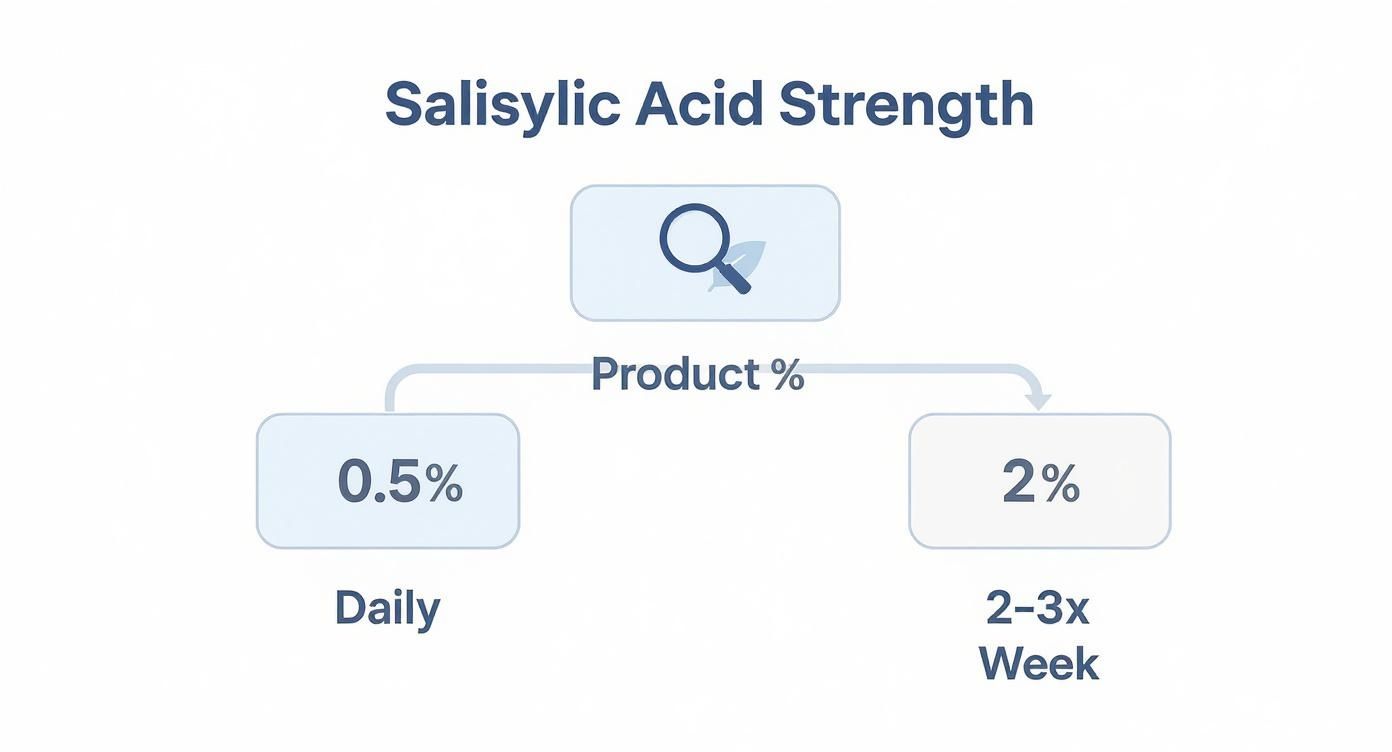
The takeaway is straightforward: lower concentrations like 0.5% are often gentle enough for more frequent use, while higher strengths around 2% demand a more cautious approach to prevent irritation.
Ultimately, you want to build a routine that feels instinctive. When you're in tune with your skin, you're in control. This ensures powerful, well-formulated products like those from Neutralyze can do their job effectively without pushing your skin over the edge.
Think of it as a conversation. Your skin tells you what it needs, and you adjust your routine in response. This partnership is the secret to long-term skin health, allowing you to manage acne without causing new problems.
Building Salicylic Acid Into Your Daily Routine
Figuring out where a new active ingredient fits into your skincare lineup can feel puzzling. But slotting salicylic acid into your daily routine is more straightforward than it seems. The trick isn't just what you use, but how all the pieces work together for maximum effect.
The Two Golden Rules: Moisturize and Protect
Let’s get the non-negotiables out of the way first. Since salicylic acid is an exfoliant, it can be drying. That's why you must follow it up with a good, non-comedogenic moisturizer. This simple step helps keep your skin barrier happy, hydrated, and strong, allowing the active ingredients to work more effectively.
The second golden rule? Sunscreen. Every single day. Salicylic acid can leave your skin more vulnerable to sun damage. To protect your progress and prevent post-acne marks from darkening, a broad-spectrum SPF of 30 or higher is your best friend every morning.
Timing is Everything: AM vs. PM Routines
Knowing how ingredients interact is crucial for getting results without irritation. Salicylic acid is a team player with hydrating ingredients like hyaluronic acid and niacinamide.
However, you need to be more strategic when using it alongside other heavy-hitters like retinoids or benzoyl peroxide. A classic pro-tip is to split them up: use your salicylic acid in the morning and a retinoid at night. This gives each active ingredient space to work its magic without overwhelming your skin.
If you're tackling stubborn acne and want to use both BHA and another powerhouse, our guide on using salicylic acid and benzoyl peroxide together breaks down exactly how to do it safely.
Here’s a practical look at how you could structure your day and night routines to incorporate salicylic acid effectively.
Sample AM/PM Salicylic Acid Routine
| Time of Day | Step 1 | Step 2 (Salicylic Acid) | Step 3 | Step 4 |
|---|---|---|---|---|
| Morning | Gentle Cleanser | Skip Salicylic Acid | Hydrating Serum/Moisturizer | SPF 30+ |
| Evening | Neutralyze Salicylic Acid Cleanser | Toner (optional) | Moisturizer | Neutralyze Spot Treatment |
This approach allows the salicylic acid to work deeply overnight while your skin is in its natural repair cycle.
By dedicating your evening routine to exfoliation and treatment, you let the active ingredients do the heavy lifting without being exposed to sunlight or environmental stressors. This simple split helps deliver consistent, clear results while keeping irritation at bay.
Recognizing The Warning Signs Of Overuse
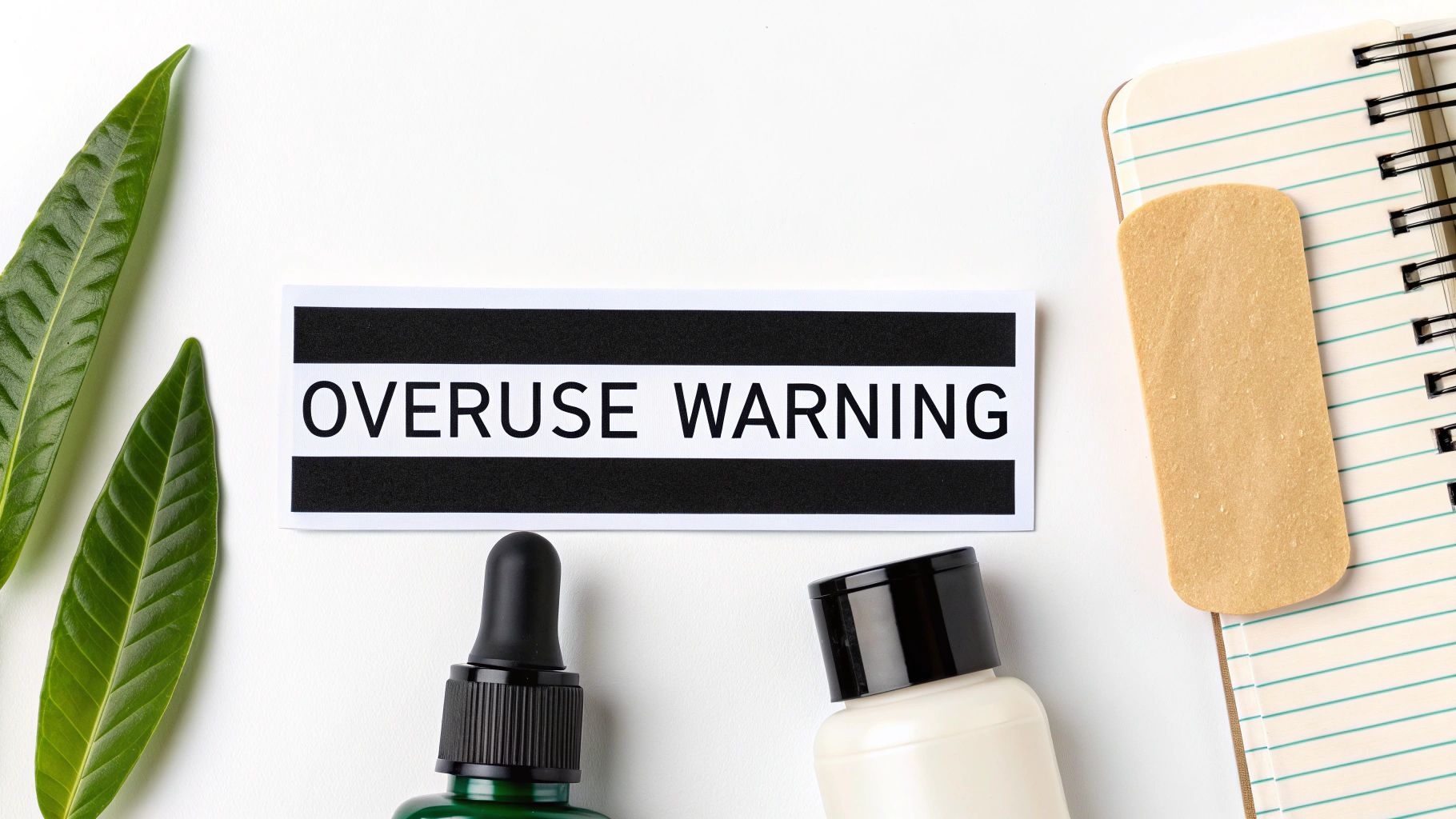
When you’re desperate to clear a breakout, it’s tempting to go all-in with salicylic acid. But a healthy, intact skin barrier is your best defense against acne, and over-exfoliating is the fastest way to wreck it.
The real skill is learning to listen to your skin. Instead of trying to "push through" the irritation, you have to see it for what it is: a stop sign. This is a core philosophy at Neutralyze—we believe that supporting long-term skin health is always better than aggressive, short-term fixes that cause more problems down the line.
What Over-Exfoliation Looks Like
Trust us, your skin will let you know when you’ve overdone it. The trick is to catch the subtle hints before they turn into a full-blown crisis.
Keep an eye out for these classic red flags:
- Persistent Redness: A little flush right after application can be normal. But if your face stays red and blotchy for hours, that's a sign of inflammation.
- Unusual Dryness and Flaking: Salicylic acid should help with oil, but it shouldn't leave your skin feeling like sandpaper. If you see peeling and flaking, especially around your nose and mouth, you've gone too far.
- A Tight, 'Stripped' Feeling: Your skin should feel clean after washing, not squeaky and uncomfortably tight. That "squeaky" feeling means you've stripped away the healthy oils that keep it protected.
- Sudden Sensitivity: This is a big one. Is your go-to gentle moisturizer suddenly stinging? That's a textbook sign of a compromised skin barrier.
A damaged skin barrier can't do its job of keeping irritants out and moisture in. This often leads to even more sensitivity and, ironically, more breakouts. The solution isn't more acid; it’s giving your skin the support, hydration, and time it needs to heal.
If you start ticking off any of these boxes, you need to take action right away.
Your Immediate Action Plan
The second you suspect overuse, hit the brakes. Stop using salicylic acid and any other "active" ingredients in your routine—that means retinoids, vitamin C, AHAs, and other exfoliants.
Strip your routine down to the bare essentials for at least a week. Think of it as a skin reset. All you need is:
- A gentle, hydrating cleanser
- A soothing, barrier-repair moisturizer
- Daily sunscreen (non-negotiable!)
Once your skin feels calm and hydrated, you can reintroduce salicylic acid. But this time, go slow. Start with just once or twice a week and see how your skin responds. You're trying to find that sweet spot where you get the benefits without any of the damage.
Your Salicylic Acid Questions, Answered
Even with a solid routine, questions are bound to pop up. As experts in salicylic acid, we want to provide the right answers so you can use it confidently and get the best possible results. Let's walk through some of the most common questions.
Can I Use Salicylic Acid Every Day?
This depends entirely on the product and your skin's tolerance.
A gentle, low-concentration cleanser (like the one in our Neutralyze systems) is often formulated for daily use, especially once your skin adapts. However, for stronger leave-on products like serums or toners, starting with 2-3 times per week is the safest and most effective approach. Only increase the frequency if your skin shows no signs of tightness, flaking, or irritation. Your skin will always tell you what it needs.
How Long Until I See Results?
Patience is crucial. While you might notice less oiliness within the first week, the real acne-clearing magic takes time.
For visible improvements in acne, blackheads, and texture, you're generally looking at 4-6 weeks of consistent use. It takes that long for salicylic acid to effectively clear out congested pores and prevent new blemishes from forming. Remember, a consistent routine with a well-formulated product is far more effective than using high-strength treatments sporadically.
Can I Mix Salicylic Acid with Vitamin C or Retinol?
Yes, but you have to be strategic to avoid overwhelming your skin. Layering them all at once is a recipe for irritation.
Here’s a simple way to do it:
- Vitamin C in the morning: It’s an antioxidant, so it's perfect for daytime protection.
- Salicylic acid at night: Let it work on clearing out your pores while you sleep.
If you’re also using a retinoid, it's best to alternate nights. One night salicylic acid, the next night retinol. This gives your skin a break and dramatically reduces the risk of irritation. If your skin is sensitive, you might have to pick just one active to use at a time.
When your at-home routine isn't quite cutting it, professional treatments can give you that extra boost. For example, professional Clarifyme Facials are designed to deeply cleanse pores and improve clarity, which perfectly complements the goals of a salicylic acid regimen.
What Should I Do If My Skin Gets Red and Flaky?
Stop. Full stop.
Redness and peeling are your skin's emergency signals that its protective barrier is damaged from over-exfoliation. Immediately press pause on salicylic acid and any other potent actives (retinoids, vitamin C, etc.).
Strip your routine back to the bare essentials:
- A creamy, hydrating cleanser
- A simple, soothing moisturizer focused on barrier repair
- Sunscreen. Every single day.
Only after your skin has completely calmed down—which could take a week or more—should you consider reintroducing salicylic acid. And when you do, start over with a much lower frequency, maybe just once a week, to see how it responds.
Finding your way with active ingredients is a journey, and Neutralyze is here to make it simpler. Our scientifically formulated systems are designed to deliver potent, acne-fighting results while respecting your skin barrier, giving you the confidence to achieve clear, calm skin. Discover the balanced approach to acne treatment at Neutralyze.

